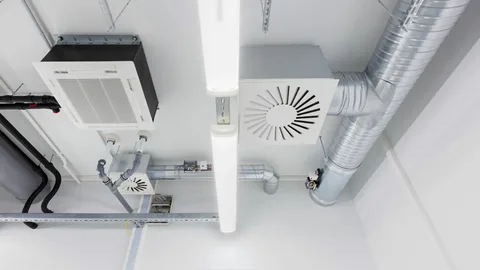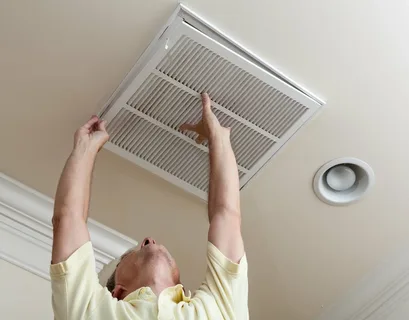Are you looking to improve the air quality in your home, reduce humidity, and enhance overall comfort? Look no further than installing home ventilation system. A ventilation system is a crucial component of any home, as it helps to circulate air, control humidity levels, and maintain indoor air quality. In this blog post, we will explore the various benefits of having a ventilation system in your home and provide expert advice on how to choose the right one for your needs.
An Introduction to Home Ventilation Systems
A home ventilation system plays a pivotal role in ensuring a fresh and healthy environment inside your dwelling. By strategically replacing stale, polluted indoor air with fresh outdoor air, it tackles various airborne nuisances head-on. This system is adept at whisking away pollutants, allergens, and unwanted moisture, thereby safeguarding your living space from the potential hazards these elements pose. The market offers a plethora of options, ranging from simple extractor fans to sophisticated whole-house fans and heat recovery ventilators. Each type serves a specific purpose and fits different requirements, making the choice of a suitable system a critical decision for homeowners.
Understanding the mechanics and benefits of these systems is the first step towards creating a healthier, more comfortable indoor environment. With advancements in technology, modern ventilation solutions are designed to be energy-efficient, ensuring that fresh air doesn’t come with a hefty price tag on your energy bill. As we delve deeper into the types and functionalities of home ventilation systems, it’s important to keep in mind your specific needs to find a solution that aligns perfectly with your home’s architecture and your personal lifestyle.
Improving Air Quality with Effective House Ventilation System
An effective house ventilation system is instrumental in enhancing the quality of air within your home, offering a solution to the challenge of indoor pollutants which can significantly impact health and comfort. Through the constant exchange of indoor and outdoor air, ventilation systems minimise harmful substances, such as volatile organic compounds (VOCs), carbon monoxide, and other chemical pollutants that may emanate from everyday household products and activities.
Especially in modern, well-sealed homes, where natural air infiltration is limited, a dedicated ventilation system becomes paramount to prevent the accumulation of stale air and contaminants. By introducing fresh, filtered air into the home, these systems reduce the risk of health issues associated with poor indoor air quality, such as respiratory conditions, headaches, and fatigue.
Moreover, effective ventilation supports a living environment where odours, smoke, and cooking fumes are efficiently expelled, creating a fresher and more pleasant indoor atmosphere. Thus, investing in a robust ventilation system is a key step towards safeguarding the health and enhancing the wellbeing of all occupants by providing a continuous supply of clean air.
The Role of Ventilation in Humidity Control
Managing humidity within your home is critical to prevent a multitude of moisture-related issues, such as the proliferation of mould and mildew, which damage your home’s structure and pose significant health risks. Ventilation systems play a vital role in mitigating these risks by systematically removing excess moisture from the air. This is particularly important in home areas prone to high humidity levels, such as kitchens, bathrooms, and laundry rooms. By ensuring a consistent flow of drier outside air into these spaces, ventilation systems help to balance indoor humidity levels, keeping them within a healthy and comfortable range.
This process is essential for preserving the integrity of building materials and furnishings, which excessive moisture can adversely affect. Moreover, by curbing the growth of mould and mildew, ventilation systems contribute to a cleaner and more hygienic indoor environment, safeguarding the health and wellbeing of occupants. Implementing a well-designed ventilation strategy is, therefore, pivotal in maintaining an optimal indoor humidity level, enhancing the overall living conditions within your home.
Reducing Energy Costs with Residential Ventilation Systems
Installing residential ventilation systems can have a significant impact on reducing energy costs in your home. By ensuring efficient air circulation, these systems prevent the buildup of humidity and reduce reliance on air conditioning during warmer months. In colder seasons, certain ventilation systems, such as those with heat recovery capabilities, can recover heat from outgoing stale air and transfer it to incoming fresh air, reducing the need for additional heating. This ability to regulate the temperature inside your home through natural air circulation reduces the workload on your heating, ventilation, and air conditioning (HVAC) system, resulting in substantial energy savings.
Additionally, a well-designed ventilation system can reduce the occurrence of dampness and the need for dehumidifiers or other energy-intensive appliances aimed at moisture control. This contributes to a more sustainable living environment and translates into lower electricity bills. By optimizing airflow and utilizing natural temperature regulation, domestic ventilation systems offer a cost-effective solution to achieving a comfortable indoor climate without excessive energy consumption.
The Connection between Ventilation and Sleep Quality
Ensuring your bedroom is well-ventilated plays a crucial role in enhancing sleep quality. Air circulation not only aids in maintaining a comfortable temperature but also in reducing humidity levels. Such an environment is conducive to sleep, as it mimics the natural drop in body temperature that signals to your brain it’s time to rest. A ventilated room minimises the presence of pollutants and allergens, which can irritate the respiratory system or trigger allergies, potentially disrupting sleep patterns.
Furthermore, fresh air supply has been associated with reducing CO2 levels in the bedroom, promoting deeper and more restful sleep. It’s noteworthy that ventilation systems can be particularly beneficial for individuals with asthma or allergic rhinitis, as they help create an indoor climate that is less likely to exacerbate their conditions. Integrating effective ventilation can thus transform your bedroom into a sanctuary that supports uninterrupted, high-quality sleep, making it an indispensable element for anyone looking to improve their sleep hygiene.
Expert Advice on Choosing the Right Home Ventilation System Design
Selecting the appropriate ventilation system design for your home requires careful consideration of several key factors. First and foremost, assess your property’s size and each room’s specific ventilation needs. Larger areas might necessitate more powerful systems or multiple units to ensure efficient air circulation. The local climate also plays a crucial role; homes in humid regions may benefit from systems with dehumidifying capabilities, while those in colder areas might consider heat recovery ventilators to conserve energy while maintaining a fresh air supply.
Additionally, it’s important to evaluate the energy efficiency of different systems. Opting for ancient model can sig model significantly reduce operating costs without compromising on air quality. Look for systems with a high Energy Star rating or utilising eco-friendly technologies.
Consideration should also be given to the installation process and potential modifications to your home’s structure. Some systems may require extensive ductwork, affecting installation costs and timelines. Consulting with a professional can provide valuable insights into the most suitable options based on your home’s layout and existing HVAC infrastructure.
Finally, factor in the system’s noise level, particularly for units installed near bedrooms or living areas, to ensure it won’t disrupt the comfort and tranquillity of your home environment. By considering these considerations and seeking professional guidance, you can select a home ventilation system design that meets your specific needs and enhances the livability of your space.
Maintenance Tips for Your Ventilation System
Maintaining your home’s ventilation system is key to ensuring it functions optimally, preserving your living space’s air quality and comfort. Regular maintenance checks can significantly extend the lifespan of your system while preventing potential malfunctions that could compromise its efficiency. It is advisable to initiate a routine wherein filters are cleaned or replaced according to the manufacturer’s guidelines, typically every three to six months. This is crucial for preventing the accumulation of dust and debris, which can obstruct airflow and diminish the system’s efficacy.
In addition to filter maintenance, inspecting ductwork and vents for any blockages or signs of damage is important. Ensure that furniture or curtains do not obstruct vents to maintain unimpeded airflow. Periodic checks by a professional can also uncover issues that may not be immediately apparent to the homeowner, such as leaks or wear within the ducts.
Furthermore, keeping the external components of your system, such as exhaust and intake vents, free from obstructions like leaves or snow is essential for maintaining proper ventilation. These simple yet effective steps contribute to the longevity of your ventilation system and support a healthier and more energy-efficient home environment.
Maximising Home Ventilation Systems Australia Benefits with Proper Use
To fully reap the rewards of home ventilation systems Australia, it’s pivotal to tailor their usage to the unique climate conditions prevalent across the continent. Australia’s weather patterns, ranging from tropical in the north to temperate in the south, necessitate a strategic approach to ventilation. During the sweltering summer months, employing night-time ventilation can exploit cooler evening air, effectively reducing indoor temperatures and alleviating the load on cooling systems.
Conversely, in cooler regions or during the winter, systems with heat recovery features can capture warmth from expelled indoor air to pre-heat incoming fresh air, maintaining a comfortable indoor environment without excessive energy consumption. Moreover, understanding your system’s specific settings and operational modes can optimise performance; for instance, adjusting the humidity control settings to local weather conditions can prevent excess moisture accumulation, a common issue in coastal and tropical areas.
If available, engaging with the system’s smart features to schedule operation times can also enhance efficiency, ensuring the system runs when it’s most beneficial. By adapting your ventilation system to align with Australia’s diverse climates and leveraging technology for intelligent operation, you can maximise the health and comfort benefits it delivers to your home.
Conclusion
Integrating a ventilation system within your residence is a transformative move towards fostering a healthier, more comfortable habitat. Opting for an ideal system tailored to your home’s requirements and leveraging it judiciously not only augments air quality but also aids in maintaining an equilibrium in humidity levels whilst ushering in considerable energy savings. This proactive approach ensures the well-being of your dwelling’s occupants by mitigating health risks associated with poor air quality and excessive humidity. Furthermore, by understanding and applying the principles of effective ventilation, homeowners can embrace a sustainable lifestyle that harmonises with the environment. It is through informed decisions and correct usage that the full spectrum of benefits offered by home ventilation systems can be realised, thereby enhancing the livability of your space.
FAQs
How does home ventilation system differ from an air conditioning unit?
Whilst both systems enhance the comfort of indoor environments, their core functions diverge significantly. A ventilation system is engineered to replace stale indoor air with fresh outdoor air, improving air quality and circulation. In contrast, an air conditioning unit focuses on modifying the temperature of indoor air, either cooling or heating it and often recirculates the same air rather than introducing fresh air from outside.
What is the recommended frequency for changing filters in a ventilation system?
To ensure the optimal performance of your ventilation system, it is advisable to change the filters every three to six months. This interval can vary based on the system’s operational intensity and the presence of pollutants within your home environment. Consistent filter replacement is vital for preventing the buildup of pollutants, which can hinder the efficiency of your system and degrade indoor air quality.
Can installing a ventilation system in my home help in reducing the presence of allergens?
Indeed, a well-functioning ventilation system plays a crucial role in mitigating the levels of allergens present in your home. Ventilation systems help remove airborne allergens such as dust mites, pollen, and animal dander by facilitating the constant exchange of indoor air with filtered, fresh outdoor air. This process purifies the air and creates a healthier living space for individuals prone to allergies, enhancing their comfort and wellbeing.
| Related Business Listings | |||||||||||||
| Contact Directory | |||||||||||||
Local Business Profiles
|



